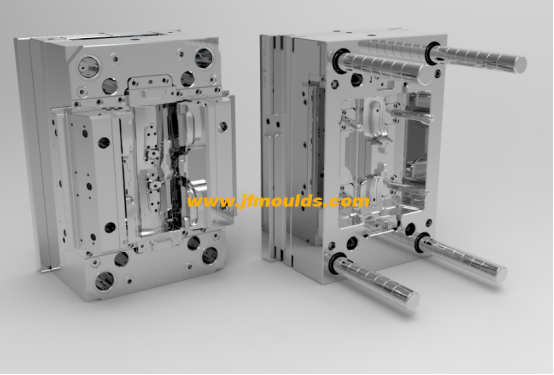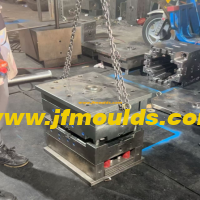The coordinated evolution of technological iteration and industrial ecosystem
The coordinated evolution of technological iteration and industrial ecosystem
I. The Technical Foundation and Contemporary Value of Injection Molds
As a core piece of equipment in modern manufacturing, the technological evolution of injection molds can be regarded as a micro-industrial revolution history. From the rudimentary molds when the world's first manual injection molding machine was born in the mid-19th century to today's intelligent molds capable of achieving nanoscale precision, this leap not only reflects the advancement of materials science and manufacturing processes but also reveals the deep reconstruction of the global industrial chain.
In the contemporary industrial system, the value of injection molds has long transcended the category of "tools". A set of automotive bumper molds needs to achieve high-speed opening and closing at 1.5 times per minute while ensuring dimensional tolerances within 0.1mm. A set of medical syringe molds needs to be produced continuously for 100,000 times in a Class 100 clean workshop, and the inner wall smoothness error of each finished product should not exceed 5 microns. Behind these strict requirements lies the core position of molds as the "carrier of industrial genes" - they determine the performance ceiling of end products and also influence the market competitiveness of manufacturing enterprises.
Car bumper mold Manufacturer in China (jfmoulds.com)
Ii. Core Technological Breakthroughs and Practical Cases of Injection Molds
(1) Breakthrough in the limits of precision forming technology
Modern injection molds have broken through the precision ceiling of traditional manufacturing. The surface roughness of the mold cavity processed by ultra-precision grinding technology can be controlled within Ra0.02μm, which is equivalent to maintaining mirror-like flatness even after magnifying the diameter of a human hair by 1000 times. This kind of precision is particularly crucial in the field of optics. A certain enterprise has developed a mold for AR glasses lenses. By using S136 mirror steel and five-axis linkage processing, the light transmittance of the lenses has been increased to 99.2%, which is 3 percentage points higher than that of traditional processes.
Microfoaming injection molds demonstrate another dimension of technology. By injecting nitrogen into the melt to form micron-sized bubbles, the product weight can be reduced by 15% to 30%, and surface shrinkage marks can be eliminated at the same time. After a certain mobile phone manufacturer adopted this technology, the cooling time of its body shell mold was shortened from 25 seconds to 18 seconds, the single-module production capacity increased by 28%, and the annual electricity cost savings exceeded 800,000 yuan.
(2) Innovative design of molds with complex structures
Facing the forming challenges of irregular-shaped parts, mold designers have developed a variety of special structures. For the complex inner cavity of the intake manifold of automotive engines, a mold with 3D-printed conformal cooling water channels was adopted, which increased the cooling uniformity by 40% and reduced the scrap rate from 5% to 0.8%. The two-color injection mold, through a rotating core structure, can complete the composite molding of two materials on the same equipment. After a certain home appliance enterprise adopted this technology for the coffee machine handle mold, the assembly process was reduced by 60% and the production efficiency was increased by three times.
The innovation of the inverted core-pulling mechanism is even more ingenious. A certain children's toy mold, through the linkage design of the inclined top and the rack, has achieved synchronous cocore pulling at three inverted parts inside the product. The mold's closing height has been reduced by 120mm, and the energy consumption of the injection molding machine has been decreased by 15%. This structural innovation not only solved the molding problem but also brought about significant economic benefits.
(3) Cross-border integration of materials technology
The selection of mold materials has entered the "customization" era. In response to the molding requirements of high-temperature nylon materials, a new type of mold steel with a vanadium content of 0.2% has been developed. Its heat resistance temperature has been raised to 380℃, extending the mold life by 2 to 3 times compared to traditional materials. In corrosive environments, the die steel manufactured by powder metallurgy technology has a chromium content of 16% and a salt spray resistance of over 2000 hours. It has been successfully applied to the shell molds of seawater monitoring equipment.
Breakthroughs have also been made in surface treatment technology. The diamond-like carbon coating (DLC) mold developed by a certain enterprise has a surface hardness of HV3000 and a friction coefficient reduced to 0.08, which reduces the demolding force of polytetrafluoroethylene products by 70% and solves the molding problem of viscous materials.
Motorcycle plastic mold Manufacturer in China (jfmoulds.com)

Iii. Ecological Construction and Regional Characteristics of the Injection Mold Industry Chain
(1) Collaborative network of the industrial chain
The injection mold industry has formed a full-chain ecosystem of "design - materials - processing - service". Upstream die steel enterprises such as SSAB of Sweden and Baosteel of China have shortened the die manufacturing cycle by providing pre-hardened steel. Midstream processing equipment manufacturers such as DMG of Germany and Makino of Japan can achieve positioning accuracy of 0.001mm for their five-axis machining centers. Downstream service enterprises offer value-added services such as mold leasing and maintenance. A certain platform has increased the equipment utilization rate of small and medium-sized manufacturers by 40% by sharing idle mold resources.
This synergy effect is particularly significant in the Yangtze River Delta region. From mold design companies in Shanghai to precision processing workshops in Suzhou and injection molding production bases in Ningbo, the entire process from drawings to finished products can be completed within a 200-kilometer radius. This industrial cluster has shortened the mold delivery cycle by 30% compared to the global average.
(II) Differentiated Paths of Regional Competition
German molds are renowned for their "precision". The dimensional repeatability accuracy of their automotive molds can reach 0.005mm. A certain enterprise developed a headlamp mold for Mercedes-Benz, which achieved the perfect formation of complex curved surfaces through 28 sets of hydraulic core-pulling mechanisms. Japan, on the other hand, focuses on small and precision molds. The cavity roughness of its camera lens molds reaches Ra0.01μm, which is equivalent to a mirror reflectivity of over 95%.
China's mold industry shows a gradient development feature: The Pearl River Delta mainly focuses on molds for fast-moving consumer goods. The beverage bottle cap mold of a certain enterprise can achieve a high-speed production of 1,200 times per minute. The Yangtze River Delta region mainly focuses on automotive and electronic molds. The battery casing molds for Tesla's Shanghai factory are provided by local enterprises. The Chengdu-Chongqing region, relying on its cost advantage, has rapidly risen in the field of medical device molds.
Iv. Practical Challenges and Solutions for the Injection Mold Industry
(1) Technical barriers and cost pressures
High-end molds still face a "bottleneck" predicament. The core components of a certain chip packaging mold rely on imports, with a unit price as high as 800,000 yuan and a delivery cycle as long as six months. The fluctuations in raw material prices are equally severe. In 2024, the price of die steel rose by 18% year-on-year, and as a result, the profits of a medium-sized die enterprise were compressed by 12 percentage points.
The solution lies in technological substitution and process optimization. A certain enterprise has reduced costs by 30% while maintaining performance by replacing imported materials with domestic H13 steel. Another enterprise introduced the MES system, reducing the waiting time for mold processing procedures by 40% and indirectly lowering costs by 15%.
(II) Talent Gap and Training Models
Mold designers need to have knowledge in multiple disciplines such as mechanics, materials, and software. Currently, there are less than 5,000 talents in China who master the advanced Moldflow simulation technology. The joint training between enterprises and universities has become the key to breaking the deadlock. A certain vocational college has jointly built a training base with a mold enterprise. Students can independently complete simple mold design within three months after graduation, which is twice as efficient as the traditional training mode.
V. Future Prospects and Technological Frontiers of Injection Molds
(1) Intelligent and Digital transformation
Digital twin technology is reshaping the mold industry. A certain enterprise's intelligent mold, with 16 built-in sensors, collects real-time data such as cavity pressure and temperature, and combines AI algorithms to predict the mold's lifespan, reducing maintenance costs by 25%. 3D printing technology has revolutionized traditional manufacturing. Mold inserts made using the SLM process have a 60% improvement in the conformability of cooling water channels and a 20% reduction in the product molding cycle.
(II) Green Manufacturing and Sustainable Development
Environmentally friendly molds have become a new trend. A certain enterprise has developed a special mold for degradable plastics, which has solved the problem of easy degradation of materials through a special exhaust structure, increasing the qualification rate of corn starch products from 75% to 92%. Mold remanufacturing technology is also becoming increasingly mature. A certain enterprise has extended the service life of old molds by 50% through laser cladding repair, while reducing steel consumption by 30 tons per year.
Vi. Conclusion
The development level of the injection mold industry is an invisible yardstick for measuring a country's manufacturing strength. From ballpoint pen tip molds to aerospace accessory molds, every technological breakthrough has driven the progress of industrial civilization. In this smokeless industrial competition, only by adhering to technological innovation and ecological synergy can a true "industrial cornerstone" be forged. In the future, injection molds will not only be forming tools but also become key nodes connecting the digital world and the physical world, writing a vivid footnote for intelligent manufacturing.
Related News
Exploring Injection Molds: Unlocking the Core Code of Plastic Molding
2025-07-10
Exploring Injection Molds: Unlocking the Core Code of Plastic Molding In the ...
Solutions for the rubber powder and inner side scratches on the sprue of the mold
2025-09-03
Solutions for the rubber powder and inner side scratches on the sprue of the mol...
Solutions for trapped gas burning, surface wire clamping and insufficient glue in the inner column of the mold
2025-08-11
Solutions for trapped gas burning, surface wire clamping and insufficient glue i...
Injection molds: The Cornerstone and Future Trend of Precision Manufacturing
2025-07-12
Injection molds: The Cornerstone and Future Trend of Precision ManufacturingBasi...
Explore Huangyan Mould Industry in Deepseek Eyes Together
2025-06-19
1. development process and industrial scale 01 historical evolution Huangyan mol...
Solutions for mold clamping lines, surface clamping marks and clamping position sticking to the mold
2025-08-15
Solutions for mold clamping lines, surface clamping marks and clamping position ...





